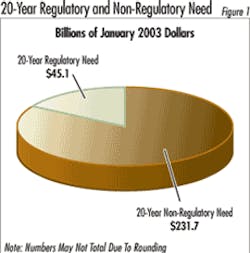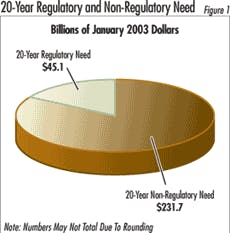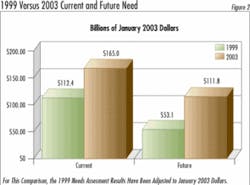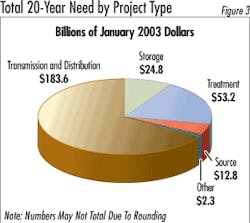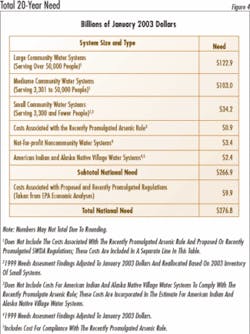EPA Report to Congress Examines US Drinking Water System Needs
A recently released survey conducted by the U.S. Environmental Protection Agency shows that drinking water systems in the United States will need to spend at least $276.8 billion over the next 20 years to install, upgrade, and replace drinking water infrastructure.
EPA’s third national assessment of public water system infrastructure, the 2003 Drinking Water Infrastructure Needs Survey and Assessment, covers the 20-year period from January 1, 2003, through December 31, 2022. The need includes installation of new infrastructure as well as rehabilitation or replacement of deteriorated or undersized systems. It also includes the need to address aging infrastructure that is adequate now but will require replacement or significant rehabilitation over the next 20 years.
The national total includes the investment needs of the nation’s approximately 53,000 community water systems and 21,400 not-for-profit noncommunity water systems.
As mandated by the Safe Drinking Water Act, EPA uses the results of the most recent infrastructure needs assessment to allocate Drinking Water State Revolving Loan Fund monies to the states based on their share of the total national need, with each state receiving at least 1 percent of the available DWSRF funds.
Eligible projects are funded according to each state’s priority system, consistent with public health criteria specified in the SDWA. EPA also uses the assessment results to allocate the tribal set-aside (up to 1.5 percent of the DWSRF annual appropriation) for American Indian and Alaska native village water systems.
Need Breakdown
The nation’s 1,041 largest community water systems (those serving populations of more than 50,000 people) account for $122.9 billion, or 44 percent, of the total national need. Medium and small community water systems also have substantial needs of $103 billion and $34.2 billion, respectively.
The 2003 Needs Assessment differentiates “current needs” from “future needs.” About 60 percent of the total needs, $165.0 billion, are identified as current needs. Although current needs have increased in dollars from previous assessments, they are a smaller percentage of the total need in 2003 (60 percent, compared with 68 percent in 1999).
Current needs are projects that a system considers a high priority for near-term implementation to enable a water system to continue to deliver safe drinking water. For instance, a system may have had numerous leaks and breaks in a section of main that should be replaced before a major main break occurs and inhibits the delivery of safe drinking water.
A system with current needs is not necessarily in violation of any health-based drinking water standard or in the midst of responding to an emergency. For example, a surface water treatment plant may currently produce safe drinking water, but the plant’s filters may require replacement because of their declining effectiveness. By replacing the filters the plant would continue providing safe water and avoid emergency situations.
Future needs are projects that water systems do not currently need, but would expect to address in the next 20 years as part of routine rehabilitation or replacement of infrastructure because of predictable events, e.g., reaching the end of a facility’s service life. Approximately 40 percent of the total need, $111.8 billion, is reported as future needs.
To be consistent with the eligibility requirements for the DWSRF, the 2003 Needs Assessment did not include projects that would be undertaken solely to accommodate future growth (e.g. extension of service lines to new housing developments). However, for both current and future needs, the 2003 Needs Assessment did include DWSRF-eligible projects that had reasonable accommodation for expansion of capacity that is consistent with the design life of the infrastructure (e.g., replacing deteriorated 6-inch pipe with new, and larger capacity, 12-inch pipe).
Total Need: Project Type
Every project in the 2003 Needs Assessment belongs to one of five categories of need: transmission and distribution, treatment, source, storage, or “other.”
Transmission and Distribution. With $183.6 billion needed over the next 20 years, transmission and distribution projects constitute the largest category of need, accounting for almost two-thirds of the total. Little of this category is related to any federal mandate. Instead, utilities need to install and maintain distribution systems to provide potable water to their customers while preventing contamination of that water prior to delivery.
The transmission and distribution category also comprised the largest proportion of the total need in the 1995 and 1999 Needs Assessments. Its increased share of the total in 2003 reflects EPA’s emphasis on fully capturing previously underreported rehabilitation and replacement needs, most of which were in this category.
The transmission and distribution category includes the installation and rehabilitation of raw and finished water transmission mains and distribution mains and replacement of lead service lines, flushing hydrants, valves, meters, and backflow prevention devices.
Treatment. Treatment projects represent the second largest category of need, $53.2 billion, nearly one-fifth of total need, over the next 20 years. This category consists of projects needed to reduce contaminants through treatment processes such as filtration, disinfection, corrosion control, and aeration.
Storage. The total 20-year need for storage projects is $24.8 billion. This category includes projects to construct new or rehabilitate existing finished water storage tanks. Many projects in this category involve rehabilitating existing tanks to prevent structural failures or sanitary defects that can allow microbiological contamination.
Source. The source category includes projects that are necessary to obtain safe supplies of surface water or ground water. The infrastructure needs in this category include the installation and rehabilitation of drilled wells and surface water intakes. The total 20-year needs for source water projects are $12.8 billion.
Other. Other needs account for an estimated $2.3 billion. This category captures needs that cannot be assigned to one of the prior categories. Examples include emergency power generators not associated with a specific system component, computer and automation equipment, and projects for system security.
Regulatory Need
Although all of the infrastructure projects included in the 2003 Needs Assessment promote the SDWA’s public health objectives, most are driven by the need to provide an essential service to the utility’s customers. However, some of the projects are directly attributable to specific SDWA regulations.
The total regulatory need is divided into two broad categories: the need associated with existing SDWA regulations, and the need associated with recently promulgated and proposed regulations.
The second category accounts for new or proposed regulations that may impact systems in the near future, even though systems have not yet determined the extent to which they will need capital investment to achieve compliance. The total regulatory need is $45.1 billion, or only 16 percent of the total national need.
Existing SDWA Regulations
The estimated needs directly associated with existing SDWA regulations (including the recently promulgated Arsenic Rule that will be effective in January 2006) are $35.2 billion. The total capital cost of compliance with the recently promulgated Arsenic Rule (from the Economic Analysis for the final rule) was included in this category because state-specific occurrence data were available, allowing EPA to allocate costs to states.
Microbial Contaminants
Projects that address microbiological contamination comprise 86 percent, or $30.2 billion, of the total existing regulatory need. They typically fall under the SDWA, the Surface Water Treatment Rule (SWTR), the Interim Enhanced Surface Water Treatment Rule (IESWTR), and the Total Coliform Rule (TCR). The installation of a treatment plant to filter a surface water source or the replacement of an aging disinfection system are examples of needs in this category.
Chemical Contaminants
Projects designed to protect the public health from chemical contaminants comprise $5.0 billion, or 14 percent, of the total existing regulatory need. This category includes projects necessary for compliance with the existing Nitrate/Nitrite Standard, the Lead and Copper Rule, the Total Trihalomethanes Standard, and the recently promulgated Arsenic Rule, as well as other regulations that set maximum allowable limits for organic and inorganic contaminants. Examples of projects in this category include aeration facilities to remove volatile organic compounds or projects to add corrosion control to reduce the leaching of lead from pipes.
Proposed or Recently Promulgated Regulations
The total need associated with proposed and recently promulgated regulations is $9.9 billion. Of this total, $3.2 billion is for the regulation of acute contaminants under the Long Term I and/or the Proposed Long Term 2 Enhanced Surface Water Treatment Rules (LT1ESWTR and/or LT2ESWTR), the Proposed Ground Water Rule, and the Filter Backwash Recycling Rule.
The remaining $6.7 billion is for chronic contaminants regulated under the Stage 1 and/or the Proposed Stage 2 Disinfectants/Disinfection Byproducts Rules (Stage 1 and Stage 2 DBPR), the proposed Radon Rule, and the recently promulgated Radionuclides Rule.
The 2003 Needs Assessment obtained the costs for this category from the Economic Analysis published for each rule; they are not estimates from respondents to the 2003 Needs Assessment questionnaire. These costs are added to the total national need for this assessment, but do not affect individual states’ total need or allocation because the Economic Analysis relies on regional data only.
Security Needs
Water systems have long included protections against vandalism and natural disasters as part of their water system improvement programs. However, systems have only recently begun to address more robust security needs to identify and protect the system from terrorist-type activities. Because the 2003 Needs Assessment was concurrent with this expanded security evaluation and planning process, many systems may not have adequately captured these specific needs for the assessment.
Systems with completed vulnerability assessments and corrective action plans often did not have documented costs for those improvements. These were not the types of costs that EPA was prepared to model. It is anticipated that these needs will be more completely reported in future assessments. The total security need estimated from the 2003 Needs Assessment is $1.0 billion.
Needs for Small Water Systems
Approximately 45,000 of the nation’s 53,000 community water systems serve 3,300 or fewer people. Small water systems’ 20-year infrastructure need is estimated to be $34.2 billion. The total is based on findings from the 1999 Needs Assessment, adjusted to 2003 dollars and applied to the 2003 inventory of small systems. Small water systems face many unique challenges in providing safe drinking water to consumers. The substantial capital investments required to rehabilitate, upgrade, or install infrastructure, without the economies of scale available to larger systems, represent one challenge.
Although the total small system need is modest compared to the need of larger systems, the costs borne on a per-household basis by small systems are significantly higher than those of larger systems.
To download a copy of EPA’s 2003 Drinking Water Infrastructure Needs Survey and Assessment, visit http://www.epa.gov/safewater/needssurvey/index.html. Information on the Drinking Water State Revolving Fund allotment program, including state allotment percentages for 2005, is available at http://www.epa.gov/safewater/dwsrf/allotments/index.html
